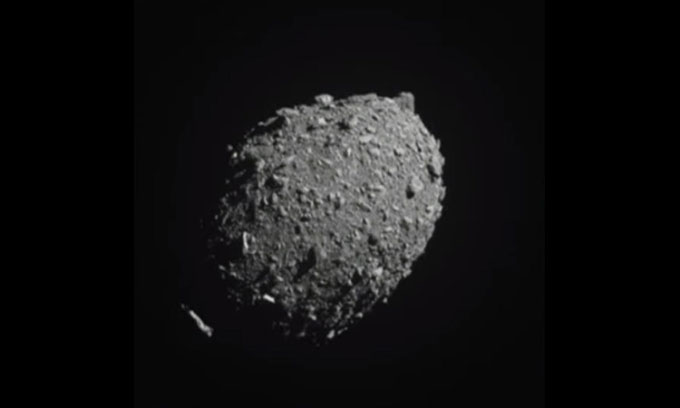A Collision with the DART Spacecraft Could Shorten Dimorphos’ Orbit by Several Minutes, but Experts Need Days to Observe It.
The Double Asteroid Redirection Test (DART) spacecraft from NASA collided with the small asteroid Dimorphos, located 11 million kilometers from Earth, at 6:14 AM on September 27 (Hanoi time). This marks the world’s first planetary defense experiment using “kinetic impactor.”

Image of the asteroid Dimorphos observed by the DART spacecraft just before collision, about 2 minutes prior. (Photo: NASA/JHUAPL).
The mission’s goal is to alter the orbital period of Dimorphos and consequently change its gravitational influence on Didymos, the larger asteroid in the binary system with Dimorphos, thereby shifting the orbit of the asteroid pair. However, scientists cannot immediately determine if the orbit has changed as planned.
When observed from Earth, the Didymos-Dimorphos binary asteroid system appears as a small bright dot in the star-filled sky. This dot brightens and dims periodically as Dimorphos (over 160 meters wide) orbits Didymos (780 meters wide), temporarily obscuring Didymos.
From the frequency of these brightness dips, astronomers have determined that Dimorphos has an orbital period of 11 hours and 55 minutes. Based on this, they will also calculate how much Dimorphos’ orbit changes after the DART collision. The asteroid is expected to be pushed closer to Didymos, resulting in a faster orbital period by several minutes. However, experts are uncertain about exactly when this acceleration and shortening of the orbit can be observed.
“It’s like when you break your wristwatch and it starts running a little fast. You might not notice it in the first day or two, but after a few weeks, you’ll start to see that it no longer keeps the correct time,” said Tom Statler, a scientist for the DART program at NASA’s Planetary Defense Coordination Office.
The scientists involved in the DART mission have only a preliminary understanding of the extent of the changes the impact will cause. This is because they know very little about Dimorphos. The effectiveness of the collision will depend heavily on the unknown properties of Dimorphos, such as its density and internal structure. For DART to be considered successful, it must shorten Dimorphos’ normal orbital period by 73 seconds. However, some scientists believe the outcome could be even greater, potentially up to 10 minutes.
“Telescopes will monitor the timing of the brightness dips—when Dimorphos passes in front of Didymos. Within a few days or weeks, we should see these dips occurring out of schedule. Personally, I would be surprised if a month goes by without seeing this change clearly. However, we cannot confirm that just yet,” Statler stated.
According to the European Space Agency (ESA), ground-based telescopes can also observe and measure the sudden brightening caused by debris ejected during the DART impact. This material will create a temporary comet-like tail that will help astronomers determine some characteristics of Dimorphos.
“The more material that is ejected from the asteroid, the greater the amount of material that can reflect sunlight, increasing brightness in the sky,” explained Dora Föhring, an astronomer at the ESA’s Near-Earth Object Coordination Center.
“This is the first time such an activity has been tested, so it’s hard to predict the amount of material ejected from the collision. Current estimates suggest that the asteroid will increase in brightness by about one magnitude (apparent brightness), but in the most extreme scenarios, the brightness could increase by up to 4 magnitudes,” Föhring added.
Telescope observations from southern and eastern Africa, the eastern Arabian Peninsula, and Southeast Asia will be able to capture the moment of impact. In the coming days, hundreds of professional and amateur telescopes will target Didymos, including the two most powerful space observatories, the James Webb Telescope and the Hubble Telescope.


















































